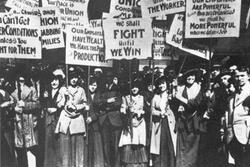Lessons on the Labor Movement from Bessie Hillman
A few months ago, I was discussing a book I had read about online with my dad, called Capitalist Realism. The author, writer, and political theorist Mark Fisher, believed that anti-capitalism and revolutionary politics had become yet another branded source of profit. Fisher argues that capitalism and consumerism have become so ubiquitous that our societal consciousness is incapable of imagining an alternative. Bleak. But I was intrigued by the topic and wanted to learn more about it. I had just searched up the Amazon reviews of the book and was adding it to my virtual cart when I realized the irony of what I was doing. I joked to my dad that buying an anti-capitalist book on Amazon is literally Fisher’s theory in action. Instead of completing my order, I sighed and never purchased the book.
Amazon has become such a ubiquitous force in American life that even writing this sentence feels redundant. Executive Chairman Jeff Bezos is known globally, primarily for his gleaming bald head and net worth of 122 billion dollars. Amazon is the second-largest American employer. Yet perhaps no corporation has received as much criticism for its labor practices as this sleek machine. Employees scattered through over one thousand American warehouses have come forward with stories of working to exhaustion in extreme heat and unrealistic time constraints, forcing employees to urinate in bottles and skip meals. A cellphone ban in an Illinois warehouse prevented workers from viewing emergency alerts as a tornado approached the warehouse (which the storm destroyed soon after, killing six Amazon workers). And during the pandemic, COVID safety protocols were increasingly rolled back in warehouses where many were falling ill, with employees claiming that the only PPE they were given was one Clorox wipe per shift.
The sheer scale of the population that Amazon employs– at least 1.1 million Americans– is more than enough for a successful union, but the company’s executives have taken every possible measure to ensure that their employees don’t unite. Since its founding, Amazon has gained notoriety for crushing the organizing efforts of trade unions almost as quickly as they begin. In 2001, 850 workers in Seattle were laid off by the company immediately following a major unionization drive. Unsurprisingly, the corporation denied any connection between the attempt to unionize and the subsequent mass layoffs. Amazon has been accused of posting anti-union signs in bathrooms, training managers to spot behaviors in workers that may lead to unionization, and surveilling employees’ digital activity for pro-union content.
Amazon’s efforts today recall the rampant union-busting efforts of the early 20th century. The Corporations Auxiliary Company, for example, was a corporation literally founded to conduct espionage on possible unionization efforts in major industrial cities. Amazon’s surveillance of its employees serves as a modern incarnation of the Auxiliary Company’s undercover operators who spied on working-class factory and mine laborers. Union efforts in the 20th century persisted, however, with immigrants and women often taking the lead. No one figure serves as the champion of the revolutionary union movement, but Bessie Abramowitz Hillman comes close.
Born in the Linoveh shtetl in Grodno (now Belarus) in 1889, Bessie challenged the norm from adolescence: at age 16, she moved to Chicago with two of her cousins to escape the possibility of an arranged marriage. Upon her arrival in the United States, Bessie took up work in the Hart Schaffner & Marx factory as a button sewer. But Bessie was fired by the factory after organizing a protest challenging low salaries and unsafe working conditions. Not one to be defeated by a simple firing, Bessie managed to get reemployed by Hart Schaffner & Marx, albeit under a pseudonym. Shortly after, she organized a walkout in protest of the poor factory environment.
Initially mocked, her original troupe of sixteen women climbed to 8,000 as more and more female factory workers became conscious of their power in numbers. Men from other factories joined the strike, and with the support of the Women’s Trade Union League, Bessie’s movement grew to 40,000 frustrated and dynamic blue-collar workers – especially women. Bessie sparked a romance with Lithuanian Jew Sidney Hillman, the founder of the Amalgamated Clothing Workers of America union, and they married in 1916. Over the next thirty years, Bessie performed volunteer labor for the Clothing Workers union after deciding with her husband that only one member of the couple should receive a salary for their union work. Sidney Hillman died in 1946, and Bessie was elected vice president of the union to which she had devoted her adult life In 1961, Eleanor Roosevelt invited Bessie to join the Presidential Commission on the Status of Women, where Bessie fought for laws protecting women’s labor rights. Bessie died in 1970 in New York City after a lifetime of unshakable and zealous commitment to the rights of female garment workers.
Since 2017, when Amazon acquired Whole Foods, the JFK8 warehouse in Staten Island, New York has become the hub of unionization efforts. During the pandemic, New York workers advocating for proper safety protocols and COVID-19 prevention were consistently intimidated by Amazon management. Chris Smalls, a worker at the JFK8 warehouse, was fired from his job in 2020 following a walkout he organized in protest of Amazon’s COVID protocol. Like Bessie Smalls a century before him, he used his firing as fuel for his desire to unionize and fight back against Amazon’s labor injustices. In April 2021, Smalls established the Amazon Labor Union, and in January 2022, the JFK8 facility voted in favor of the ALU. The Staten Island warehouse thus became the first independent Amazon union in the United States.
Both Amazon organizer Chris Smalls and Russian Jewish labor activist Bessie Hillman were instrumental in founding the first unions in their respective factories in the face of immeasurable odds and intimidation by their employers. To Amazon, just as to Hart Schaffner & Marx, the activist's organization represented an acute threat to the practices and livelihood of their corporation’s survival. Bessie fought her entire life for the labor rights that women under the JFK8 union are currently exercising. Chris Smalls drew national attention to the Staten Island warehouse and informed the American public that the individuals who ship goods at the drop of a hat were being exploited. These American activists changed the scope of unions in their times. They continue to remind their fellow workers, their managers, executives, and the people that they are real, they are unwavering, and they are ready to fight.
This piece was written as part of JWA’s Rising Voices Fellowship.







